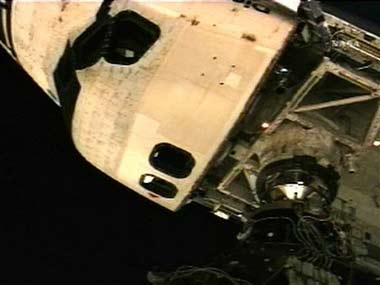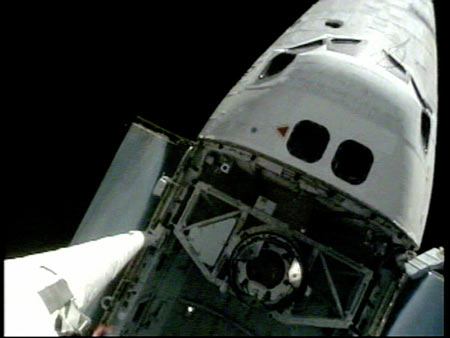Center
Shuttle docks with space station
(AP)
Updated: 2006-07-07 11:22
 |
Large Medium Small |
 In this image made from NASA TV,the Space Shuttle Discovery's docking port is visible from a camera mounted on the International Space Station prior to the pair docking, July 6, 2006. [AP Photo] |
Life in space returned Thursday to as close to normal as it has been since the Columbia disaster three years ago.
After the space shuttle Discovery docked with the international space station, the orbiting outpost was fully staffed with three crew members for the first time since 2003. European Space Agency astronaut Thomas Reiter arrived on the shuttle for a six-month stay.
The news for Discovery was also reminiscent of more carefree days: NASA found no major problems with the shuttle's heat shield.
Pictures taken by the space station crew, as Discovery approached for the linkup, uncovered no serious concerns with the thermal tiles, said deputy shuttle program manager John Shannon. He called that "somewhat of a surprise, but a very pleasant surprise." By Thursday evening, experts on the ground had analyzed many of the 352 digital images.
The pictures revealed a second protruding thermal tile filler on the shuttle's underside, and engineers were assessing whether the flaws posed any risk for re-entry. A small piece of fabric was also a little loose behind the nose.
|
|
"Overall, it was a great look at the vehicle, and we're struggling a little bit to find areas to go look at with our focused inspection" on Friday, said Shannon, chairman of the mission management team. During the inspection, astronauts will use the shuttle's robotic arm and extended boom to take close-up pictures of four areas that engineers need to examine.
During a meeting to discuss problems "we were looking for things to talk about," Shannon said. "The vehicle is doing so well."
The biggest piece of foam insulation to come off the external fuel tank was 12 inches by 14 inches and no more than an inch thick, Shannon said. It was well within safety limits in size and because it fell later in the launch, he said.
After a lunchtime hatch opening, both crews, seven on the arriving shuttle and two on the station, exchanged hugs and handshakes and relished the trouble-free flight. Then they started to transfer more than 5,000 pounds of supplies from the shuttle to the space station.
"Everybody's having fun," American astronaut Jeff Williams, who has been on the station since March 31, radioed back to Earth. "I don't see a sad person in the crowd."
On the ground, NASA officials happily noted the lack of problems 220 miles above the Earth.
"It's boring to us that it's quiet," lead flight controller Tony Ceccacci said. "But it's a good thing. It means that everything is going well."
Even though the mission was progressing smoothly, the control center had not returned to a sense of normalcy, Ceccacci said. "It's more of a sense of, 'Hey, the things we've done to make the ... tank better are working,'" he said.
Before Discovery docked with the station Thursday, commander Steve Lindsey flew the shuttle into a back flip maneuver so the space station crew could take photographs of the tiles on Discovery's belly.
Engineers were looking for signs that hard insulating foam from the shuttle's external tank hit the shuttle during launch. Damage from falling foam led to Columbia's destruction in 2003, when all seven astronauts died after fiery gases entered a breach in a wing during re-entry.
The day before, astronauts on Discovery used a boom and the shuttle's robotic arm to take 70 minutes of video of the shuttle's nose cone and wings. Engineers spent much of Wednesday and Thursday examining the video for signs of damage. As of Thursday afternoon, they had found areas "of interest" but not of concern, Ceccacci said.
Mission managers told Discovery's crew Thursday about six probable impacts that had been detected by sensors on the leading edge of the shuttle's wings, and officials were investigating.
Shannon said the sensors were probably recording the passage of shock waves and described the risk as "beyond minor."
Cameras also found foam strikes 19 seconds after launch and just under five minutes after launch. But neither impact was during the critical 75-second period a couple minutes after launch when the foam would have enough speed to cause damage, NASA officials said.
Discovery's mission is to test shuttle-inspection techniques and deliver supplies to the space station. Astronauts Piers Sellers and Michael Fossum plan to carry out two spacewalks, and possibly a third, which would extend the 12-day mission by a day. The first spacewalk, set for Saturday morning, involves a daring spacewalk on top of an extension boom that engineers say is similar to painting a house from a rickety ladder.
